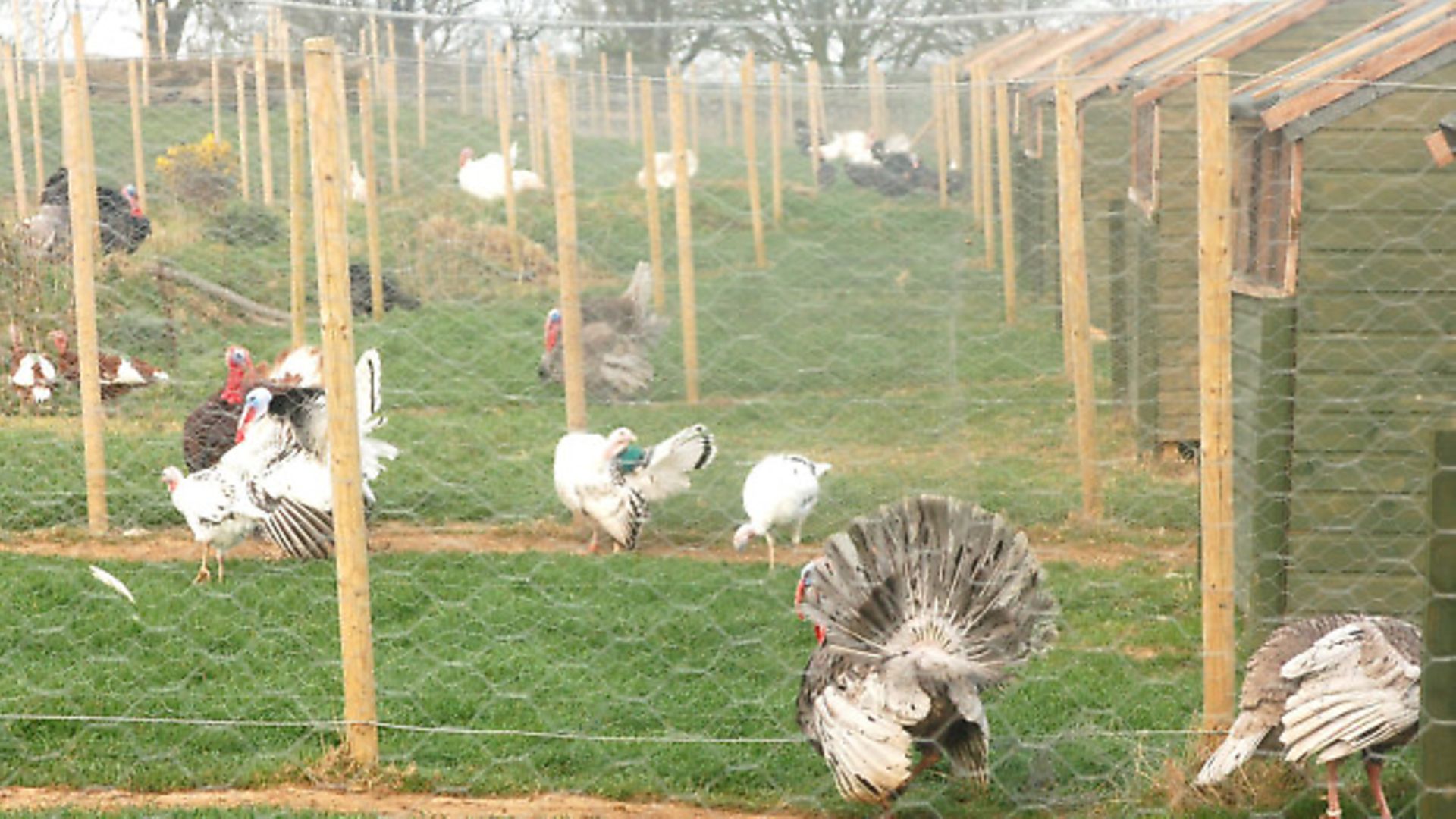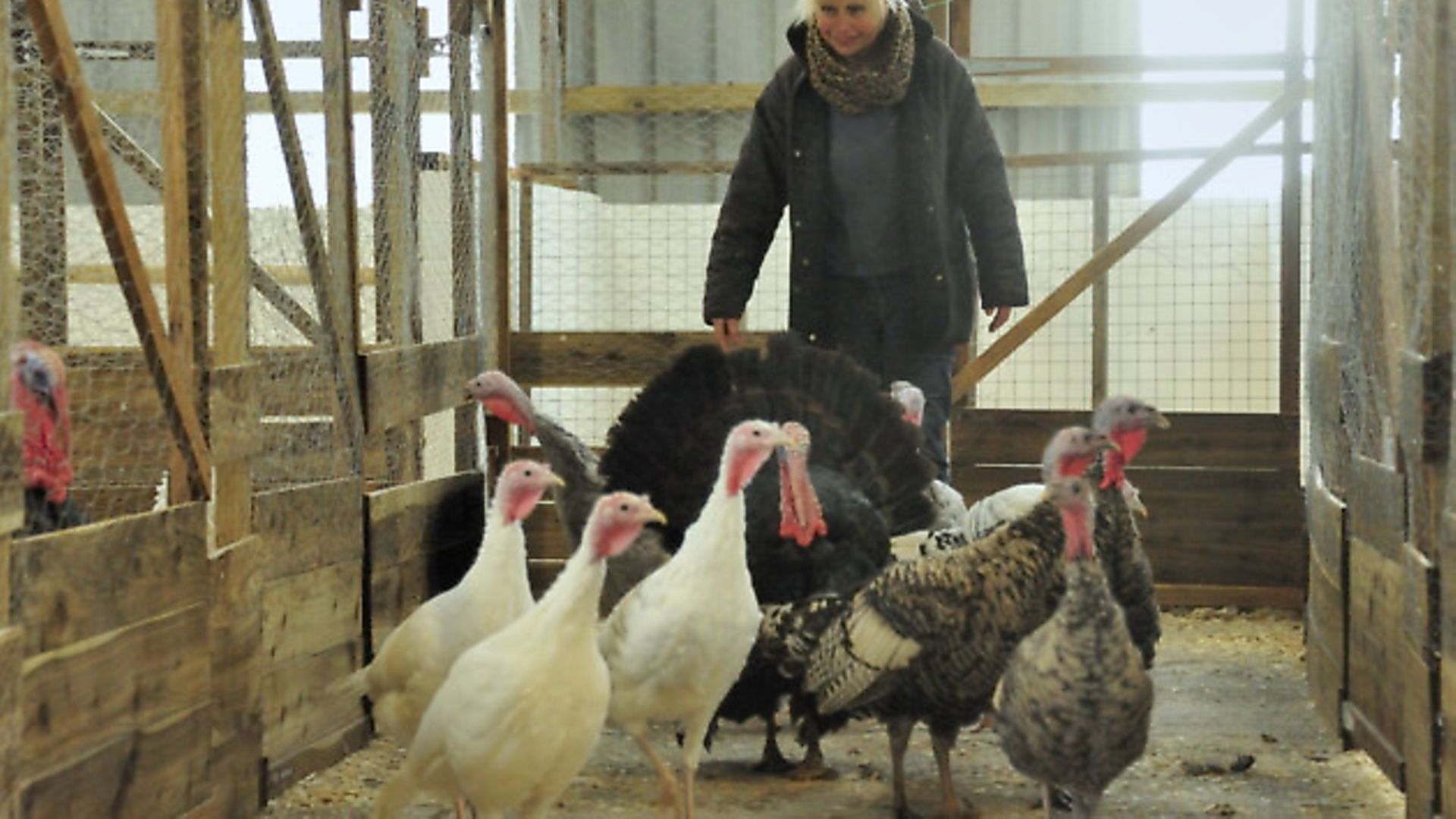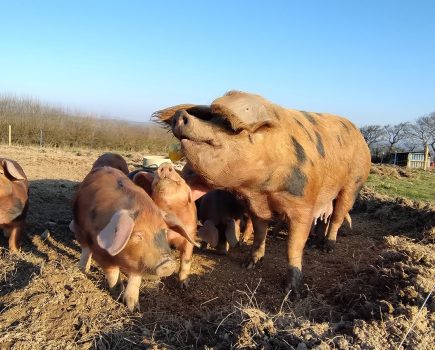Terry Beebe talks to Janice Houghton-Wallace, a leading light in the turkey world

If there is one person who has done more than anyone else to promote the keeping of turkeys, it is Janice Houghton-Wallace.
Janice is the driving force behind The Turkey Club UK, which was set up in 2001 to conserve and promote standard varieties of turkey. As well as being the club’s secretary, she is also a top exhibitor of the various turkey breeds, winning many awards with her wonderful birds.
Janice is former producer at the BBC, who worked on the popular Countryfile programme, and now lives in Newton Stuart, the gateway to the Galloway Hills in Scotland. It is here that she keeps her large flock of turkeys. She has a very large area on which she keeps a wide variety of the different breeds.

Tell us about your favourite breed
This is a difficult one because all the standard varieties of turkey have their own special characteristics. Initially it was the Blue (Lavender) and, when I retired from the BBC, the Countryfile office secretly bought me a pair as a leaving present. I was so taken aback with this kind thought and very humbled that anyone should think of such a wonderful gift. However, after having turkeys for a long time now, if I am forced to choose it will have to be the Narragansett. A well marked Narragansett stag in full plumage, fit and showy to me is stunning. I adore the muted tones of beige and grey amongst the other coloured markings.
What first attracted you to the breed?
Once I was keeping turkeys it was my ambition to have all the standard varieties and I had read up about the Narragansett as well as seen pictures in books. Because of its history and the fact that even today these standard turkeys are relatively rare worldwide, especially the Narragansett, I felt I wanted to have and help this wonderful bird.
Where did you get them and how much did you pay?
I imported my Narragansetts at just a few days old, along with Bourbon Red, Slate, Spanish Black and Royal Palm (the American equivalent of Pied (Crollwitzer). Sixty poultry came from Bill Braden and Gerald Donnelly in Canada and the project took two years to arrange and complete. It was quite an expensive but exciting venture and, along with the actual cost of the poults, the veterinary fees, Canadian Ministry fees, facilitating costs, airline flight, cargo handling, veterinary inspection, quarantine facilities at home, birds from Compton Animal Health Research Centre, MAFF tests (this was 2001 before DEFRA), my veterinary surgeon inspection costs and lots of paperwork transactions, the total bill was just under £3,000.
What is it about the breed that most appeals to you?
The turkey is an avian breed and there are different varieties of this bird. I grew up on a farm where turkeys were reared for Christmas – it was my mother’s task. I helped with every aspect of looking after them but did so because that is what we as a family did. It was not until later in life when I started exhibiting pure breed poultry and ran a poultry show that I started to think about turkeys in a different light. I put some turkey classes on in the show and thought I had better support them, so I went to the Domestic Fowl Trust and they had eight Bourbon Red poults for sale. I had only intended to buy three or four but when there are eight there… From thereon in I was hooked. These poults were amazingly interesting little characters and won me over.
Turkeys are extremely inquisitive and, if time is given to them, will respond to you and indeed, want to be around you and see what is going on. They do seem to be capable of learning and will put trust in those they see fit to be trusted.
Do you have any fond memory of a particular bird?
You could not have asked a more pertinent question. Petunia was so very special and I know I will never ever come across another bird like her. Petunia was a Bourbon Red female and was hatched with a disability. The right side of her head was slightly pushed in so that her eye did not open fully and her beak at the end was not shaped as it should be. At three days old her siblings began to bully her so I took her away and put her under a cosy brooder on the kitchen work top. Being one for always trying to help the underdog, I thought if she could eat and drink properly I would give her a chance. From that moment on there was no looking back.
Petunia grew and certainly could eat and drink. She said on my lap whilst I was at the computer and we often talked to one another. She would get used to going outside and eventually – because she had to know she was a turkey and not a human – Petunia had her own small house outside. She had the run of the garden and would walk down to the turkey pens and talk with the other birds.
She became an absolute pet and when we went anywhere she would sit on my wrist whilst I carried her, even when an adult bird. When I put on turkey displays at shows Petunia came too but she was not penned. I had complete faith that she would not stray from the other birds or away from the sound of my voice and she never did.
When I moved to Scotland, Petunia came too along with all the other turkeys and she managed the journey well. She became such a character that when she was slightly under the weather and I was due to steward at the Royal Highland Show, she lived at the vets so that she was cared for constantly. Even hard, commercial thinking farmers were asking after her and when eventually the time came for her to leave me, she was kept in a well bedded box in the kitchen. During this period she slept most of the time but there was a moment when she lifted her head up above the box and just looked at me before returning to sleep. When the vet came he was as upset as I.
We did actually manage to control our emotions quite well but both agreed that occasionally in life we come across remarkable people. We can also come across remarkable animals and Petunia was such a bird. Whether it was her disability that pushed her to be ‘ordinary and normal’ or whether it was a bonding from those first few days – I will never know. What I do know is that I am so glad I did not despatch her when most sensible people keeping poultry would have. She was a wonderful companion and taught me a lot.
What is the breed like as an egg producer?
Turkeys are seasonal layers, starting to lay around February/March and finishing the season from August onwards. A turkey can be expected to lay between 50 – 80 eggs in that time. Some will even extend the laying time into the autumn but generally most eggs are produced in May – July. A few people keep female turkeys for their eggs as they are great in baking and can be used just the same as chicken eggs. The yolks are thick and creamy and there is plenty of albumen. I am often asked why turkey eggs are not for sale. The answer is that it is far more economical to turn the egg into a turkey but turkey eggs can be found in some outlets but will be more expensive than chicken eggs. Usually around 75p – £1 each for eating. Eggs for hatching purposes can be £2 – 50 to £5 each depending on the variety and quality of the birds.
Are there any particular challenges in keeping this breed? Do they have any special needs?
Turkeys do not have special needs but they must be kept in a clean environment with diligent cleanliness adhered to you are likely to be more successful in rearing and keeping them.
The one big challenge that still exists with keeping turkeys is the threat of the disease Blackhead. Histomonas meleagridis is a protozoan parasite that chickens can carry but to which turkeys, peafowl and pheasants are most susceptible . The parasite is ingested in the ova of heterakis worms or as larvae in earthworms and the incubation period is 15 to 20 days. The main sign of Blackhead is a sulphur yellow diarrhoea, depression with head sunken into shoulders, a lack of appetite and emaciation. The parasite attacks the liver which is why the condition is often fatal. It is difficult to cure as the drug which has in the past been successful in dealing with this disease – Dimetridazole – has been banned from use in the European Union. Metronidazole is now recommended but the disease remains a severe threat. Good hygiene and fresh pasture help to prevent Blackhead occurring. Worming with Flubenvet, the only licensed poultry wormer treatment in the UK, every six weeks will interfere with the life cycle of the heterakis worm if it has been ingested and prevent it from working through the gut and attacking vital organs. Turkeys can be kept with chickens and other poultry so long as all birds are wormed on a regular basis. However, it is not a good idea to put turkeys on land which has been inhabited by chickens over a long period.
What is their temperament like?
If turkeys are handled from a young age they will become very tame, which is an enormous asset when fully grown. They are very gentle creatures but at mating time nature will step in and the males will fight amongst themselves and be protective of their females. This is normal behaviour, which settles again once the mating season is over. The fights can be quite vicious but only if a bird is having a particularly vicious attack on it do you need to separate them. Any wounds caused through fighting should heal quickly if a antiseptic wound powder is administered.
Some turkeys act like ‘guard dogs’ around the premises and will let you know if anyone or anything different is approaching.
Have you bred from them and was this a success?
Yes, over the years I have bred from all the varieties with great success. Sometimes it takes a little longer for fertility to be good but once some warm weather and sunshine on their back fertility usually improves. Female turkey make excellent mothers. They need to be isolated so there is no disturbance to her. The poults are most at risk during the pipping period and whilst they are just a few days old. If the hen moves quickly through being disturbed or frightened she does run the risk of squashing a poult. With care though, my experience is that this rarely happens if she is looked after properly. A female turkey that trusts you will allow you to tend to her and the poults much more readily than a fierce broody hen.
Poults hatched artificially in an incubator adapt to a cosy broody or a heat lamp easily. Initially dip the poult’s beak into a lipped drinker of water so that they drink and know where drink is in future. With protection from predators as they grow and the correct feed, they usually thrive. Clean housing is vital, anything that has previously had chickens in without being cleansed, washed and disinfected will pose health problems to the poults. Turkey poults must be fed with turkey starter crumbs. These are higher in protein than chick crumbs, which is required. Apart from chick crumbs not being a good balanced turkey formulation, some also contain coccidiostats and these are poisonous to poults.
Have you ever shown the birds? If so, was that a success?
Yes, I have taken great delight in showing turkeys and had lovely successes. I have won the Best in each variety at the major shows over the years and Champion Turkey many times. They are large birds to prepare and transport but it is wonderful to see the turkeys in their rightful place alongside the other poultry species at shows.
The public absolutely adore seeing them so this is real motivation to have them on display. By taking them to shows in public spaces we are able to get the message out that the turkey is a marvellous bird in its own right and so versatile.
Do you have any tips for others who might try this breed?
Firstly, if you have the space and time I would love people to start keeping some turkeys. I would say probably the most useful thing to advise is not to keep too many, especially at first. Turkeys are addictive creatures because they really win you over but it is easier to keep a few rather than too many.
TERRY SAYS:
I have known Janice for many years through my involvement with the poultry fancy and she has been an avid poultry fancier who has dedicted a lot of time into the conservation of pure bred turkeys. This passion has continued and has also increased the general interest in a variety of people keeping these amazing birds.
FOR
Can be tamed very easily
Very attractive appearance
Depending on variety, good for meat
Pure breed turkeys are ideal for exhibition
Ideal to keep if you have space
Produce larger eggs
AGAINST
There is very little against these birds.
Birds large size requires large area.
Mating period males can be aggressive
RESOURCES
Turkey Club UK is the breed club that promotes the standard varieties of turkey. The website is www.turkeyclub.org.uk Janice is secretary and can be contacted at Cults Farmhouse, Whithorn, Newton Stewart, DG8 8HA. Tel: 01988 600763 Email: janhwallace@aol.com.
Occasionally there are turkeys for sale and eggs during the season.
The book Not Just for Christmas – the complete guide to raising turkeys by Janice Houghton-Wallace is available from the Whithorn address. Price is £15 including p+p Cheques should be payable to J.Houghton-Wallace and the book can be signed if wished.
Image(s) provided by:
Archant
Archant







